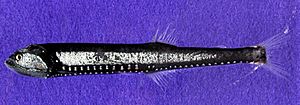Stomiiformes facts for kids
Quick facts for kids Stomiiformes |
|
|---|---|
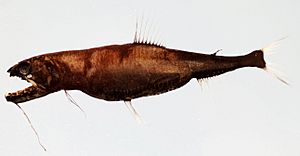 |
|
| Astronesthes similus (Phosichthyoidei: Stomiidae) | |
| Scientific classification |
|
| Kingdom: | Animalia |
| Phylum: | Chordata |
| Class: | Actinopterygii |
| Superorder: | Osmeromorpha |
| Order: | Stomiiformes Regan, 1909 |
| Suborders | |
|
Gonostomatoidei |
|
| Synonyms | |
|
Stomiatiformes |
|
Stomiiformes are a group of deep-sea ray-finned fishes. They look very different from each other. This group includes amazing fish like dragonfishes, lightfishes, loosejaws, marine hatchetfishes, and viperfishes.
There are 4 (or sometimes 5) main families in this group. These families have over 50 different types of fish, called genera, and at least 410 species. Because they live so deep, many of these fish don't have common names. But as a whole, Stomiiformes are often called dragonfishes and their relatives or just stomiiforms.
The scientific name, Stomiiformes, means "Stomias-shaped." Stomias is a type of fish in this group. The name comes from Ancient Greek words meaning "mouth" and Latin words meaning "external form." This is because many of these fish have very large mouths.
Contents
Amazing Deep-Sea Fish: Description and Life
Most Stomiiformes live in the open ocean in deep waters. You can find them all over the world, from warm subtropical areas to very cold subarctic and even Antarctic regions.
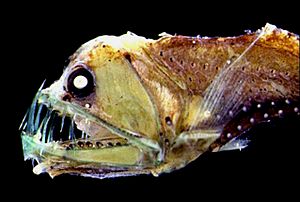
The smallest Stomiiformes fish is the bristlemouth called Cyclothone pygmaeae. It lives in the Mediterranean Sea and grows to only about 1.5 centimeters (0.6 inches) long. The largest is the barbeled dragonfish Opostomias micripnis. This fish lives in the Atlantic, Indian, and Pacific Oceans and can grow to about 50 centimeters (20 inches) long.
These fish often have a very unusual and sometimes scary look. They all have teeth on their upper jaws. Many have huge mouths that open wide, even past their eyes. Some also have a special chin barbel. Their dorsal (back) and pectoral fins (side fins) might be missing in some species. But others have an adipose fin, which is a small, fleshy fin without rays. Their pelvic fins (bottom fins) have 4 to 9 rays.
Their scales are very thin and easily fall off. Some Stomiiformes don't have scales at all. Most of them are dark brown or black. A few, like some lightfishes, are silver. Many Stomiiformes have photophores, which are special organs that make light.
The teeth of these fish are often clear and don't reflect light. This helps them hide their teeth from prey when they use their own light to hunt. Scientists have found that the clear teeth of Aristostomias scintillans are made of tiny structures of hydroxyapatite and collagen. They also don't have tiny tubes found in other teeth. However, another study showed that Chauliodus sloani (which also has clear teeth) does have these tubes. Scientists are still trying to understand why there's this difference.
Bioluminescence: Making Their Own Light
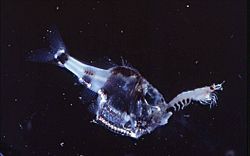
Almost all Stomiiformes have photophores, which are special light-producing organs. The light they make can be bright or dim. It can be yellow, white, violet, or red. This light is usually invisible to the animals they hunt. The way they make light can be simple, like small glowing spots. Or it can be very complex, using structures like lenses to focus the light.
Most Stomiiformes have one or two rows of photophores along their belly, from head to tail. Some also have photophores in their chin barbels. The light is made by a chemical reaction in these organs.
Daily Migration: Up and Down the Ocean
During the day, Stomiiformes stay in deep, dark waters. When the sun starts to set, many of them swim up towards the surface. These shallower waters have more food, like small fish and tiny invertebrates called plankton. During the night, these Stomiiformes hunt and eat. When the sun rises, they swim back down to deeper waters.
They seem to be able to sense how much sunlight reaches them. This helps them stay in a zone where there's very little light, but it's not completely dark. This daily up-and-down movement is common for many Stomiiformes. However, some larger Stomiiformes, which are big predators of the deep sea, stay deep all the time. They hunt smaller fish that return from the surface.
Reproduction and Life Cycle
Stomiiformes usually lay their eggs in the deep sea. But their eggs are light and float up to the ocean surface. The eggs hatch in these surface waters. When the young fish, called larvae, grow and start to look like adults, they swim down to join the other adult fish in the deep.
Some Stomiiformes, especially in the groups Cyclothone and Gonostoma, can change their sex during their lives. When they first become old enough to reproduce, they are males. Later, they change and become females.
How Stomiiformes Are Classified
Scientists group living things to understand how they are related. Stomiiformes are often placed in a larger group of teleost fish called Stenopterygii. This group sometimes includes Ateleopodiformes (jellynoses).
The Stomiiformes group is divided into two main suborders, and then into four families:
- Suborder Gonostomatoidei
- Family Gonostomatidae – These include bristlemouths and anglemouths, sometimes called "lightfishes."
- Family Sternoptychidae – These are marine hatchetfishes, bottlelights, and pearlsides.
- Suborder Phosichthyoidei
- Family Phosichthyidae – Another group of "lightfishes."
- Family Stomiidae – This family includes barbeled dragonfishes, loosejaws, and stareaters.
Timeline of Stomiiformes Genera
This timeline shows when different groups (genera) of Stomiiformes first appeared in history.
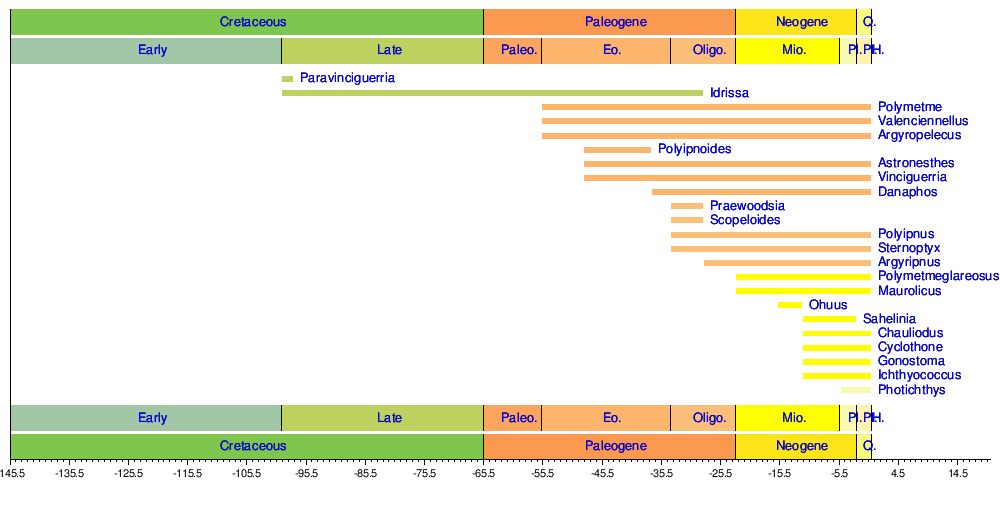
See also
 In Spanish: Estomiiformes para niños
In Spanish: Estomiiformes para niños


